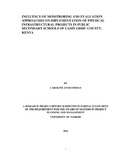Influence Of Monitroring And Evaluation Approaches On Implementation Of Physical Infrastructural Projects In Public Secondary Schools Of Uasin Gishu County, Kenya
Abstract
Monitoring and evaluation has a key role in achieving organization growth and development. Most project managers appreciate the fact that monitoring and evaluation of projects is important if the project objectives and success is to be achieved. Project monitoring and evaluation exercise adds value to the overall efficiency of project planning, management and implementation by offering corrective action to the variances from the expected standard. Project managers in the county are required to undertake more rigorous monitoring and evaluation of the projects and develop frameworks and guidelines for measuring its influence as per the settings in public secondary schools. The study was guided by the following objectives: to assess how fund utilization in monitoring and evaluation influences implementation of physical infrastructural projects in public secondary schools of Uasin Gishu County, Kenya, to assess how project scheduling in monitoring and evaluation influences implementation of physical infrastructural projects in public secondary schools of Uasin Gishu County, Kenya, to establish how quality compliance in monitoring and evaluation influences implementation of physical infrastructural projects in public secondary schools of Uasin Gishu County, Kenya and to determine how the level of stakeholder involvement in monitoring and evaluation influences implementation of physical infrastructural projects in public secondary schools of Uasin Gishu County, Kenya . The target population was drawn from public secondary schools in Uasin Gishu County with a target population of 173 public secondary schools. The participants of the study consisted of Constituency development fund (CDF) committee members, Quality Assurance (QUASO) auditors, the Ministry of Works officials, Project Management Committee from the BOM and the school Principals. The target population consisted of 537 respondents.The total sample size was therefore be 162 respondents. The data collection instruments that were used to collect data from the selected respondents were interview schedule and questionnaires. The study applied both quantitative and quantitative analysis techniques. A descriptive research design was adopted for the study. Frequency, percentages and correlation were used to analyze the data under quantitative analysis. The findings from the study indicate monitoring and evaluation approaches are in use in our public secondary schools of Uasin Gishu with a popularity of over 70% for each of them. Influence of budgeting, tendering, decision making by stakeholders and internal controls on implementation of physical infrastructural projects in monitoring and evaluation scored over 90%.This is a clear indication that they work best for the county when in use. The study has been of benefit to other counties as it is able to make them perceive an in depth overview of the monitoring and evaluation process on the ground at county level as it is and its influence. The study has been of great resource to scholars as it has immensely contributed to the body of knowledge.
Publisher
University Of Nairobi
Rights
Attribution-NonCommercial-NoDerivs 3.0 United StatesUsage Rights
http://creativecommons.org/licenses/by-nc-nd/3.0/us/Collections
- Faculty of Education (FEd) [6022]
The following license files are associated with this item:


